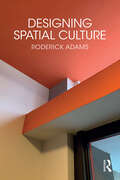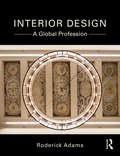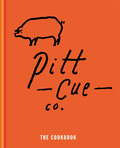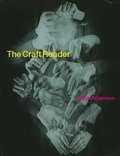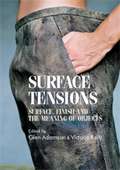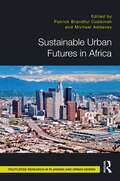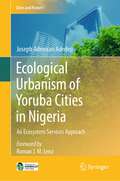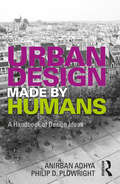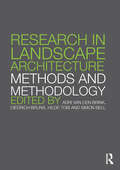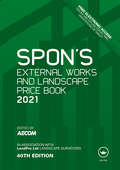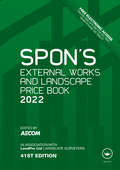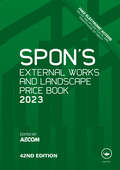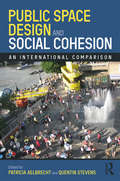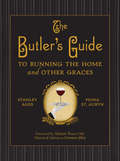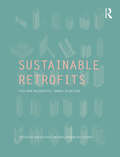- Table View
- List View
Designing Spatial Culture
by Roderick AdamsDesigning Spatial Culture investigates a powerful experiential dialogue formed between the habitation of space and a diversified cultural realm. This creative proposition binds and positions human activity and experience framing its histories, currency and future. Whilst the book distinguishes between the conditions of the existing urban/ architecture/ interior canon, it embraces a new agency of space, showcasing the encounters, assemblies and designs that shape human behaviours and the cultural forms of the built environment. Using authoritative case studies, the book examines many locations and spaces, ranging from new urban landscapes, historical domestic spaces and contemporary architecture. It embraces the most lavish and flamboyant to the most simplistic and minimal, establishing a connected cultural narrative. The book shifts the focus in the spatial realm from an object-based experience (where space is filled with things) to a more complete immersive experience (combining physical and digital). A key part of this exploration is the relationship between the architecture and the interior which is often the most predominant spatial experience and fundamental to the understanding spatial experience and existing cultures. Without the architectural enclosure, the interior would lose its site context and structure for its existence. Without an interior, architecture would not fully develop an engaging spatial experience for the user. The book rationalises this through extended use of a spatial probe which documents and summarises an evidence-based research project capturing spatial culture data from a predominantly domestic setting. The book is essential reading for students and researchers in architecture, interior design and urban design.
Designing Spatial Culture
by Roderick AdamsDesigning Spatial Culture investigates a powerful experiential dialogue formed between the habitation of space and a diversified cultural realm. This creative proposition binds and positions human activity and experience framing its histories, currency and future. Whilst the book distinguishes between the conditions of the existing urban/ architecture/ interior canon, it embraces a new agency of space, showcasing the encounters, assemblies and designs that shape human behaviours and the cultural forms of the built environment. Using authoritative case studies, the book examines many locations and spaces, ranging from new urban landscapes, historical domestic spaces and contemporary architecture. It embraces the most lavish and flamboyant to the most simplistic and minimal, establishing a connected cultural narrative. The book shifts the focus in the spatial realm from an object-based experience (where space is filled with things) to a more complete immersive experience (combining physical and digital). A key part of this exploration is the relationship between the architecture and the interior which is often the most predominant spatial experience and fundamental to the understanding spatial experience and existing cultures. Without the architectural enclosure, the interior would lose its site context and structure for its existence. Without an interior, architecture would not fully develop an engaging spatial experience for the user. The book rationalises this through extended use of a spatial probe which documents and summarises an evidence-based research project capturing spatial culture data from a predominantly domestic setting. The book is essential reading for students and researchers in architecture, interior design and urban design.
Interior Design: A Global Profession
by Roderick AdamsAs the globe shrinks and the concept of distance diminishes, this text challenges the current status quo by identifying the cohesions and specialisations of design communities across the continents. It sets out an international spatial design landscape, identifying and contouring global design practice and design hotspots from a range of case studies, interviews and design practice perspectives. Using a range of interior environments, the chapters link the origins, trends and perceptions of the interior to create new insight into trans-global design. The book expands, but also coheres the interior design discipline to ensure the subject continues to grow, develop and influence the inhabitations of the world. The book features a wealth of pedagogical elements including: Beautifully designed with over 100 full colour illustrations, photographs and examples of design work Maps and diagrams which highlight hotspots of design across the globe, providing strong graphic information Interview panels featuring professional insights from designers across the globe ‘Employability’ boxes, providing a good tips guide for students gaining employment across the globe ‘International Dimension’ boxes which strengthen the scholarship of studying interior design in a globalised way ‘Design Oddities’ box which brings into focus any new or contextual facts that help contextualise the global interior.
Interior Design: A Global Profession
by Roderick AdamsAs the globe shrinks and the concept of distance diminishes, this text challenges the current status quo by identifying the cohesions and specialisations of design communities across the continents. It sets out an international spatial design landscape, identifying and contouring global design practice and design hotspots from a range of case studies, interviews and design practice perspectives. Using a range of interior environments, the chapters link the origins, trends and perceptions of the interior to create new insight into trans-global design. The book expands, but also coheres the interior design discipline to ensure the subject continues to grow, develop and influence the inhabitations of the world. The book features a wealth of pedagogical elements including: Beautifully designed with over 100 full colour illustrations, photographs and examples of design work Maps and diagrams which highlight hotspots of design across the globe, providing strong graphic information Interview panels featuring professional insights from designers across the globe ‘Employability’ boxes, providing a good tips guide for students gaining employment across the globe ‘International Dimension’ boxes which strengthen the scholarship of studying interior design in a globalised way ‘Design Oddities’ box which brings into focus any new or contextual facts that help contextualise the global interior.
Pitt Cue Co. - The Cookbook
by Tom Adams Richard H. Turner Jamie Berger Simon AndersonWith great recipes for meats, sauces and rubs mixed with ideas for pickles, slaws, puddings and cocktails, plus features on meats, equipment and methods, the Pitt Cue Co. Cookbook is your guide to enjoying the best hot, smoky, sticky, spicy grub all year round.From Pitt Cue's legendary Pickle backs and bourbon cocktails, to their acclaimed Pulled pork shoulder; Burnt ends mash; Smoked ox cheek toasts with pickled walnuts; Lamb rib with molasses mop and onion salad; Chipotle & confit garlic slaw; Crispy pickled shiitake mushrooms; Toffee apple grunt; Sticky bourbon & cola pudding and so much more, it's all irresistibly delicious food to savour and share.
The Craft Reader (PDF)
by Glenn AdamsonFrom the canonical texts of the Arts and Crafts Movement to the radical thinking of today's "DIY" movement, from theoretical writings on the position of craft in distinction to Art and Design to how-to texts from renowned practitioners, from feminist histories of textiles to descriptions of the innovation born of necessity in Soviet factories and African auto-repair shops...The Craft Reader presents the first comprehensive anthology of writings on modern craft. Covering the period from the Industrial Revolution to today, the Reader draws on craft practice and theory from America, Europe, Asia and Africa. The world of craft is considered in its full breadth -- from pottery and weaving, to couture and chocolate-making, to contemporary art, architecture and curation. The writings are themed into sections and all extracts are individually introduced, placing each in its historical, cultural and artistic context. Bringing together an astonishing range of both classic and contemporary texts, The Craft Reader will be invaluable to any student or practitioner of Craft and also to readers in Art and Design. AUTHORS INCLUDE: Theodor Adorno, Anni Albers, Amadou Hâmpaté Bâ, Charles Babbage, Roland Barthes, Andrea Branzi, Alison Britton, Rafael Cardoso, Johanna Drucker, Charles Eames, Salvatore Ferragamo, Kenneth Frampton, Alfred Gell, Walter Gropius, Tanya Harrod, Martin Heidegger, Patrick Heron, Bernard Leach, Esther Leslie, W. R. Lethaby, Lucy Lippard, Adolf Loos, Karl Marx, William Morris, Robert Morris, László Moholy-Nagy, Stefan Muthesius, George Nakashima, Octavio Paz, Grayson Perry, M. C. Richards, John Ruskin, Raphael Samuel, Ellen Gates Starr, Debbie Stoller, Alexis de Tocqueville, Lee Ufan, Frank Lloyd Wright.
Surface Tensions: Surface, Finish and the Meaning of Objects (PDF)
by Glenn Adamson Victoria KelleySurfaces are often held to be of lesser consequence than ‘deeper’ or more ‘substantive’ aspects of artworks and objects. Yet it is also possible to conceive of the surface in more positive terms: as a site where complex forces meet. Surfaces can be theorized as membranes, protective shells, sensitive skins, even thicknesses in their own right. The surface is not so much a barrier to content as an opportunity for encounter: in new objects, the surface is the site of qualities of finish, texture, the site of tactile interaction, the last point of contact between object and maker, and the first point of contact between object and user. Surface tensions includes sixteen essays that explore this theoretically uncharted terrain. The subjects range widely: domestic maintenance; avant-garde fashion; the faking of antiques; postmodern architecture and design; contemporary film costume. Of particular emphasis within the volume are textiles, which are among the most complex and culturally rich materialisations of surface. As a whole, the book provides insights into the whole lifecycle of objects, not just their condition when new.
Sustainable Urban Futures in Africa
by Michael Addaney Patrick CobbinahSustainable Urban Futures in Africa provides a variety of conventional and emerging theoretical frameworks to inform understandings and responses to critical urban development issues such as urbanisation, climate change, housing/slum, informality, urban sprawl, urban ecosystem services and urban poverty, among others, within the context of the sustainable development goals (SDGs) in Africa. This book addresses topics including challenges to spatial urban development, how spatial planning is delivered, how different urbanisation variables influence the development of different forms of urban systems and settlements in Africa, how city authorities could use old and new methods of land administration to produce sustainable urban spaces in Africa, and the role of local activism is causing important changes in the built environment. Chapters are written by a diverse range of African scholars and practitioners in urban planning and policy design, environmental science and policy, sociology, agriculture, natural resources management, environmental law, and politics. Urban Africa has huge resource potential – both human and natural resources – that can stimulate sustainable development when effectively harnessed. Sustainable Urban Futures in Africa provides support for the SDGs in urban Africa and will be of interest to students and researchers, professionals and policymakers, and readers of urban studies, spatial planning, geography, governance, and other social sciences.
Ecological Urbanism of Yoruba Cities in Nigeria: An Ecosystem Services Approach (Cities and Nature)
by Joseph Adeniran AdedejiThis book offers in-depth ethnographic analyses of key informants’ interviews on the ecological urbanism and ecosystem services (ES) of selected green infrastructure (GI) in Yoruba cities of Ile-Ife, Ibadan, Osogbo, Lagos, Abeokuta, Akure, Ondo, among others in Southwest Nigeria. It examines the Indigenous Knowledge System (IKS) demonstrated for wellbeing through home gardens by this largest ethno-linguistic group in Nigeria. This is in addition to the ES of Osun Grove UNESCO World Heritage Site, Osogbo; Biological Garden and Park, Akure; Lekki Conservation Centre, Lagos; Adekunle Fajuyi Park, Ado-Ekiti; Muri Okunola Park, Lagos; and some institutional GI including University of Ibadan Botanical Gardens, Ibadan; Federal University of Agriculture Abeokuta Botanical Garden, Abeokuta; and University of Lagos Lagoon Front Resort, Lagos, Nigeria. The study draws on theoretical praxis of Western biophilic ideologies, spirit ontologies of the Global South, and largely, Millennium Ecosystem Assessment (2005) to examine eco-cultural green spaces, home gardens, and English-types of parks and gardens as archetypes of GI in Yoruba traditional urbanism, colonial and post-colonial city planning. The book provides methods of achieving a form of modernized traditionalism as means of translating the IKS into design strategies for eco-cultural cities. The strategies are framework, model, and ethnographic design algorithms that are syntheses of the lived experiences of the key informants.
Urban Design Made by Humans: A Handbook of Design Ideas
by Anirban Adhya Philip D. PlowrightThe design of urban environments is complex and involves diverse needs, organisations, professions, authorities, and communities. It requires relationships to be constructed and sustained between infrastructure, resources, and populations across multiple scales. This can be quite daunting. However, at the core of urban design is a simple idea—our urban spaces are designed to allow people and communities to thrive. For that reason, a good starting point for urban designers is to focus on the way people think when engaging our built environment. This thinking is embodied, developed through the interactions between our mind, body, and the environment around us. These embodied concepts are central to how we see the world, how we move and gather, and how we interact with others. They are also the same ideas we use to design our environments and cities. Urban Design Made by Humans is a reference book that presents 56 concepts, notions, ideas, and agreements fundamental to the design and interpretation of our human settlements. The ideas here parallel those found in Making Architecture Through Being Human but extends them into urban environments. Urban Design Made by Humans distinctly highlights priorities in urban design in how we produce meaningful environments catering to wider groups of people. Each idea is isolated for clarity with short and concise definitions, examples, and illustrations. They are organised in five sections of increasing complexity. Taken as a whole, the entries frame the priorities and values of urban design while also being instances of a larger system of human thinking.
Urban Design Made by Humans: A Handbook of Design Ideas
by Anirban Adhya Philip D. PlowrightThe design of urban environments is complex and involves diverse needs, organisations, professions, authorities, and communities. It requires relationships to be constructed and sustained between infrastructure, resources, and populations across multiple scales. This can be quite daunting. However, at the core of urban design is a simple idea—our urban spaces are designed to allow people and communities to thrive. For that reason, a good starting point for urban designers is to focus on the way people think when engaging our built environment. This thinking is embodied, developed through the interactions between our mind, body, and the environment around us. These embodied concepts are central to how we see the world, how we move and gather, and how we interact with others. They are also the same ideas we use to design our environments and cities. Urban Design Made by Humans is a reference book that presents 56 concepts, notions, ideas, and agreements fundamental to the design and interpretation of our human settlements. The ideas here parallel those found in Making Architecture Through Being Human but extends them into urban environments. Urban Design Made by Humans distinctly highlights priorities in urban design in how we produce meaningful environments catering to wider groups of people. Each idea is isolated for clarity with short and concise definitions, examples, and illustrations. They are organised in five sections of increasing complexity. Taken as a whole, the entries frame the priorities and values of urban design while also being instances of a larger system of human thinking.
Riverine: Architecture and Rivers
by Gerald Adler Manolo GuerciRiverscapes are the main arteries of the world’s largest cities, and have, for millennia, been the lifeblood of the urban communities that have developed around them. These human settlements – given life through the space of the local waterscape – soon developed into ritualised spaces that sought to harness the dynamism of the watercourse and create the local architectural landscape. Theorised via a sophisticated understanding of history, space, culture, and ecology, this collection of wonderful and deliberately wide-ranging case studies, from Early Modern Italy to the contemporary Bengal Delta, investigates the culture of human interaction with rivers and the nature of urban topography. Riverine explores the ways in which architecture and urban planning have imbued cultural landscapes with ritual and structural meaning.
Riverine: Architecture and Rivers
by Gerald Adler Manolo GuerciRiverscapes are the main arteries of the world’s largest cities, and have, for millennia, been the lifeblood of the urban communities that have developed around them. These human settlements – given life through the space of the local waterscape – soon developed into ritualised spaces that sought to harness the dynamism of the watercourse and create the local architectural landscape. Theorised via a sophisticated understanding of history, space, culture, and ecology, this collection of wonderful and deliberately wide-ranging case studies, from Early Modern Italy to the contemporary Bengal Delta, investigates the culture of human interaction with rivers and the nature of urban topography. Riverine explores the ways in which architecture and urban planning have imbued cultural landscapes with ritual and structural meaning.
Research in Landscape Architecture: Methods and Methodology
by Adri van den Brink Diedrich Bruns Hilde Tobi Simon BellDefining a research question, describing why it needs to be answered and explaining how methods are selected and applied are challenging tasks for anyone embarking on academic research within the field of landscape architecture. Whether you are an early career researcher or a senior academic, it is essential to draw meaningful conclusions and robust answers to research questions.Research in Landscape Architecture provides guidance on the rationales needed for selecting methods and offers direction to help to frame and design academic research within the discipline. Over the last couple of decades the traditional orientation in landscape architecture as a field of professional practice has gradually been complemented by a growing focus on research. This book will help you to develop the connections between research, teaching and practice, to help you to build a common framework of theory and research methods.Bringing together contributions from landscape architects across the world, this book covers a broad range of research methodologies and examples to help you conduct research successfully. Also included is a study in which the editors discuss the most important priorities for the research within the discipline over the coming years. This book will provide a definitive path to developing research within landscape architecture.
Research in Landscape Architecture: Methods and Methodology
by Adri van den Brink Diedrich Bruns Hilde Tobi Simon BellDefining a research question, describing why it needs to be answered and explaining how methods are selected and applied are challenging tasks for anyone embarking on academic research within the field of landscape architecture. Whether you are an early career researcher or a senior academic, it is essential to draw meaningful conclusions and robust answers to research questions.Research in Landscape Architecture provides guidance on the rationales needed for selecting methods and offers direction to help to frame and design academic research within the discipline. Over the last couple of decades the traditional orientation in landscape architecture as a field of professional practice has gradually been complemented by a growing focus on research. This book will help you to develop the connections between research, teaching and practice, to help you to build a common framework of theory and research methods.Bringing together contributions from landscape architects across the world, this book covers a broad range of research methodologies and examples to help you conduct research successfully. Also included is a study in which the editors discuss the most important priorities for the research within the discipline over the coming years. This book will provide a definitive path to developing research within landscape architecture.
Spon's External Works and Landscape Price Book 2021 (Spon's Price Books)
by AecomNow in its 40th edition, Spon's External Works and Landscape Price Book 2021 offers the only comprehensive source of information for detailed external works and landscape costs. It covers all the items to be found in hard and soft landscape contracts, and forms an indispensable reference book for quantity surveyors, landscape architects, contractors and local authority managers – essential for compiling estimates, specifications, bills of quantities and works schedules – no matter what the size of the project being undertaken. Use the access code inside the front cover of the book to get set up with an ebook of this 2021 edition on the VitalSource® Bookshelf platform, available for access and use until the end of December 2021. This NRM edition provides a revised and updated street furniture section. It also includes several new items: Kinley systems – Metal edgings and systems for landscapes and podiums New cost evaluations of water features Stainless steel landscape channel drainage All the standard features that you expect from SPON'S EXTERNAL WORKS AND LANDSCAPE PRICE BOOK remain: • material and measured work prices covering contract items from preliminaries and site clearance and encompassing the core external works activities with full breakdowns into labour, materials and other components • detailed guidance on wage rates, landscape consultants’ fee scales • an extensive Approximate Estimates section for rapid spot estimating • updates, free of charge, twice a year – see inside for registration details. Updates are available online at www.pricebooks.co.uk
Spon's External Works and Landscape Price Book 2022 (Spon's Price Books)
by AecomNow in its 41st edition, Spon's External Works and Landscape Price Book 2022 offers the only comprehensive source of information for detailed external works and landscape costs. It covers all the items to be found in hard and soft landscape contracts, and forms an indispensable reference book for quantity surveyors, landscape architects, contractors and local authority managers – essential for compiling estimates, specifications, bills of quantities and works schedules – no matter what the size of the project being undertaken. The 2022 edition includes new stainless-steel products including: ventilation grilles; handrails; LED handrails; in ground power units; stainless steel bollards; stainless steel warning strips and studs and access covers. Also, an extended range of inspection chambers, new podium specialist soils and a new formwork system, as well as two new Cost Models, one for podiums and another for landscape maintenance. All the standard features that you expect from SPON'S EXTERNAL WORKS AND LANDSCAPE PRICE BOOK remain: • material and measured work prices covering contract items from preliminaries and site clearance and encompassing the core external works activities with full breakdowns into labour, materials and other components • detailed guidance on wage rates, landscape consultants’ fee scales • an extensive Approximate Estimates section for rapid spot estimating • updates, free of charge, twice a year – see inside for registration details. Updates are available online at www.pricebooks.co.uk Use the access code inside the front cover of the book to get set up with an ebook of this 2022 edition on the VitalSource® Bookshelf platform, available for access and use until the end of December 2022.
Spon's External Works and Landscape Price Book 2023 (Spon's Price Books)
by AecomNow in its 42nd edition, Spon's External Works and Landscape Price Book 2023 offers the only comprehensive source of information for detailed external works and landscape costs. It covers all the items to be found in hard and soft landscape contracts, and forms an indispensable reference book for quantity surveyors, landscape architects, contractors and local authority managers – essential for compiling estimates, specifications, bills of quantities and works schedules – no matter what the size of the project being undertaken. The 2023 edition includes: updated key resources to obtain the latest market pricing and align with the latest supply material specifications and/or quantities guidance on land remediation, tax relief, capital allowances and aggregates levies revised rates in line with the latest market forecasts and indices, which include the impacts of Brexit, the pandemic, Ukraine supply chain disruption and the energy crisis All the standard features that you expect from SPON'S EXTERNAL WORKS AND LANDSCAPE PRICE BOOK remain: • material and measured work prices covering contract items from preliminaries and site clearance and encompassing the core external works activities with full breakdowns into labour, materials and other components • detailed guidance on wage rates, landscape consultants’ fee scales • an extensive Approximate Estimates section for rapid spot estimating • updates, free of charge, twice a year – see inside for registration details. Updates are available online at www.pricebooks.co.uk Use the access code inside the front cover of the book to get set up with an ebook of this 2023 edition on the VitalSource® Bookshelf platform, available for access and use until the end of December 2023.
Spon's External Works and Landscape Price Book 2023 (Spon's Price Books)
by AecomNow in its 42nd edition, Spon's External Works and Landscape Price Book 2023 offers the only comprehensive source of information for detailed external works and landscape costs. It covers all the items to be found in hard and soft landscape contracts, and forms an indispensable reference book for quantity surveyors, landscape architects, contractors and local authority managers – essential for compiling estimates, specifications, bills of quantities and works schedules – no matter what the size of the project being undertaken. The 2023 edition includes: updated key resources to obtain the latest market pricing and align with the latest supply material specifications and/or quantities guidance on land remediation, tax relief, capital allowances and aggregates levies revised rates in line with the latest market forecasts and indices, which include the impacts of Brexit, the pandemic, Ukraine supply chain disruption and the energy crisis All the standard features that you expect from SPON'S EXTERNAL WORKS AND LANDSCAPE PRICE BOOK remain: • material and measured work prices covering contract items from preliminaries and site clearance and encompassing the core external works activities with full breakdowns into labour, materials and other components • detailed guidance on wage rates, landscape consultants’ fee scales • an extensive Approximate Estimates section for rapid spot estimating • updates, free of charge, twice a year – see inside for registration details. Updates are available online at www.pricebooks.co.uk Use the access code inside the front cover of the book to get set up with an ebook of this 2023 edition on the VitalSource® Bookshelf platform, available for access and use until the end of December 2023.
Spon's External Works and Landscape Price Book 2021 (Spon's Price Books)
by Aecom AecomNow in its 40th edition, Spon's External Works and Landscape Price Book 2021 offers the only comprehensive source of information for detailed external works and landscape costs. It covers all the items to be found in hard and soft landscape contracts, and forms an indispensable reference book for quantity surveyors, landscape architects, contractors and local authority managers – essential for compiling estimates, specifications, bills of quantities and works schedules – no matter what the size of the project being undertaken. Use the access code inside the front cover of the book to get set up with an ebook of this 2021 edition on the VitalSource® Bookshelf platform, available for access and use until the end of December 2021. This NRM edition provides a revised and updated street furniture section. It also includes several new items: Kinley systems – Metal edgings and systems for landscapes and podiums New cost evaluations of water features Stainless steel landscape channel drainage All the standard features that you expect from SPON'S EXTERNAL WORKS AND LANDSCAPE PRICE BOOK remain: • material and measured work prices covering contract items from preliminaries and site clearance and encompassing the core external works activities with full breakdowns into labour, materials and other components • detailed guidance on wage rates, landscape consultants’ fee scales • an extensive Approximate Estimates section for rapid spot estimating • updates, free of charge, twice a year – see inside for registration details. Updates are available online at www.pricebooks.co.uk
Spon's External Works and Landscape Price Book 2022 (Spon's Price Books)
by Aecom AecomNow in its 41st edition, Spon's External Works and Landscape Price Book 2022 offers the only comprehensive source of information for detailed external works and landscape costs. It covers all the items to be found in hard and soft landscape contracts, and forms an indispensable reference book for quantity surveyors, landscape architects, contractors and local authority managers – essential for compiling estimates, specifications, bills of quantities and works schedules – no matter what the size of the project being undertaken. The 2022 edition includes new stainless-steel products including: ventilation grilles; handrails; LED handrails; in ground power units; stainless steel bollards; stainless steel warning strips and studs and access covers. Also, an extended range of inspection chambers, new podium specialist soils and a new formwork system, as well as two new Cost Models, one for podiums and another for landscape maintenance. All the standard features that you expect from SPON'S EXTERNAL WORKS AND LANDSCAPE PRICE BOOK remain: • material and measured work prices covering contract items from preliminaries and site clearance and encompassing the core external works activities with full breakdowns into labour, materials and other components • detailed guidance on wage rates, landscape consultants’ fee scales • an extensive Approximate Estimates section for rapid spot estimating • updates, free of charge, twice a year – see inside for registration details. Updates are available online at www.pricebooks.co.uk Use the access code inside the front cover of the book to get set up with an ebook of this 2022 edition on the VitalSource® Bookshelf platform, available for access and use until the end of December 2022.
Public Space Design and Social Cohesion: An International Comparison
by Patricia Aelbrecht Quentin StevensSocial cohesion is often perceived as being under threat from the increasing cultural and economic differences in contemporary cities and the increasing intensity of urban life. Public space, in its role as the main stage for social interactions between strangers, clearly plays a role in facilitating or limiting opportunities for social cohesion. But what exactly is social cohesion, how is it experienced in the public realm, and what role can the design of city spaces have in supporting or promoting it? There are significant knowledge gaps between the social sciences and design disciplines and between academia and practice, and thus a dispersed knowledge base that currently lacks nuanced insight into how urban design contributes to social integration or segregation. This book brings together scholarly knowledge at the intersection of public space design and social cohesion. It is based on original scholarly research and a depth of urban design practice, and analyses case studies from a variety of cities and cultures across the Global North and Global South. Its interdisciplinary, cross-cultural analysis will be of interest to academics, students, policymakers and practitioners engaged with a range of subject areas, including urban design, urban planning, architecture, landscape, cultural studies, human geography, social policy, sociology and anthropology. It will also have significant appeal to a wider non-academic readership, given its topical subject matter.
Public Space Design and Social Cohesion: An International Comparison
by Patricia Aelbrecht Quentin StevensSocial cohesion is often perceived as being under threat from the increasing cultural and economic differences in contemporary cities and the increasing intensity of urban life. Public space, in its role as the main stage for social interactions between strangers, clearly plays a role in facilitating or limiting opportunities for social cohesion. But what exactly is social cohesion, how is it experienced in the public realm, and what role can the design of city spaces have in supporting or promoting it? There are significant knowledge gaps between the social sciences and design disciplines and between academia and practice, and thus a dispersed knowledge base that currently lacks nuanced insight into how urban design contributes to social integration or segregation. This book brings together scholarly knowledge at the intersection of public space design and social cohesion. It is based on original scholarly research and a depth of urban design practice, and analyses case studies from a variety of cities and cultures across the Global North and Global South. Its interdisciplinary, cross-cultural analysis will be of interest to academics, students, policymakers and practitioners engaged with a range of subject areas, including urban design, urban planning, architecture, landscape, cultural studies, human geography, social policy, sociology and anthropology. It will also have significant appeal to a wider non-academic readership, given its topical subject matter.
The Butler's Guide: To Running the Home and Other Graces
by Stanley AgerPerched on an island off the shores of Cornwall, the soaring castle of St Michael's Mount has been home to Fiona St Aubyn's family since 1647. For nearly thirty years, Stanley Ager, one of the most celebrated butlers of the twentieth century, ensured that St Michael's Mount was an impeccable place to live and a gracious and welcoming destination for guests. But you don't need a manor to benefit from Ager's wisdom on running a home gracefully and efficiently. This charmingly illustrated, eminently useful volume offers his important wisdom and techniques.
Sustainable Retrofits: Post War Residential Towers in Britain
by Asterios Agkathidis Rosa Urbano GutiérrezPresenting the state-of-the-art in sustainable retrofits in post war residential towers, this book captures and re-informs the current intense refurbishing process that is taking place in Britain, which is part of a global phenomenon happening all over the world, as cities upgrade their building stock in an attempt to comply with governmental emission reduction targets. The authors present inspections of 20 sustainably retrofitted social housing towers, analysing their aesthetic and technical modifications, as well as the shifts occurring in their social structure. The authors use over 200 full colour plans, elevations, photographs, maps and illustrations to beautifully support the statistical and analytical information collected. Finally they include interviews with some of the architects who designed the retrofits, residents and key stakeholders to inform the conclusions.
